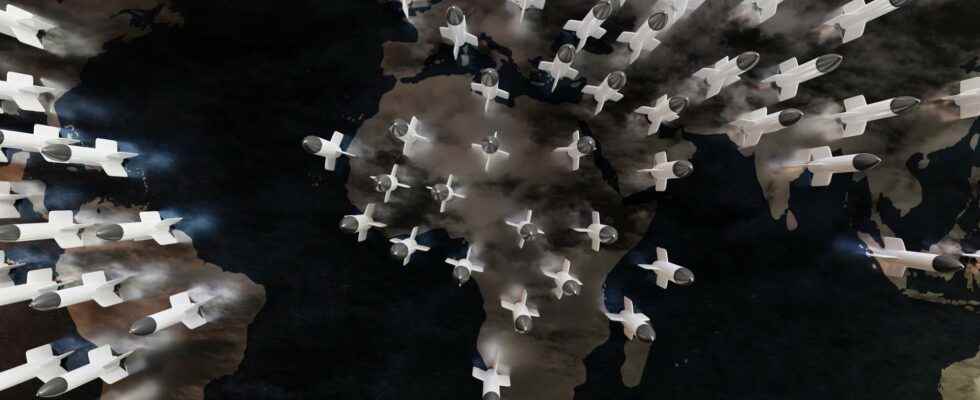The war in Ukraine, which began in February 2022, has upset diplomatic relations due to its suddenness and brutality. Many Russian political figures were quick to dangle the possibility of a nuclear escalation. But faced with this threat, what are France’s capabilities and what is its deterrent force made of?
You will also be interested
[EN VIDÉO] What is the most powerful nuclear bomb in history? On October 30, 1961, a 57 megaton atomic bomb exploded over the site of Novaya Zemlya, Russia. Baptized Tsar Bomba, it is the most powerful bomb in history.
More than forty days after the start of the war in Ukraine, on February 24, 2022, the Russian offensive patina. The war flash that Vladimir Putin seemed to want to lead did not take place, the conflict turning against the Russian army. Faced with the support of European nations and NATO member countries for Ukraine, Putin announced on February 27 raise the alert level of Russia’s nuclear forces. Bellicose rhetoric aimed at Western countries and taken up by many Kremlin personalities, from Foreign Minister Sergei Lavrov to Vladimir Putin’s press attaché, Dmitri Peskov. In the aftermath, Russia carried out posture by sending to the North Atlantic Ocean some nuclear submarineswith the aim of sending a threatening message to NATO forces.
To avoid any escalation, the United States immediately set up a direct line with the Kremlin to prevent any incident, while a test of missile intercontinental ballistic Minuteman III was postponed on March 2, to be finally canceled on 1er april. While the United States has had part of its arsenal on European territory since the Cold War, two countries in Western Europe have a nuclear strike and deterrent force: the United Kingdom and France . In recent weeks, members of Emmanuel Macron’s government have repeatedly recalled French nuclear capacity, in a dissuasive logic.
Navy and air forces: a powerful trio
On February 24, Jean-Yves le Drian, Minister of Foreign Affairs, recalled on TF1 that NATO was also “a nuclear alliance”, in response to statements threatening Vladimir Putin. If France has less than nuclear warheads deployed than Russia (about 1,500 “active”) and the United States (1,300), its arsenal amounts to 280 heads, plus 20 in reserve. They are divided between the Strategic Oceanic Forces (FOSt) and the Strategic Air Forces (FAS). The FOSt, belonging to the French Navy, has four submarines nuclear launchers submarines (SNLE) class “Le Triomphant”, named after the first device of this new generation of submarines made operational in 1997. Each SSBN (Le Triomphant, Le Vigilant, Le Terrible, Le Téméraire) is capable of welcome since 2010 sixteen sea-to-surface strategic ballistic missiles (MSBS) M51. The technicality of the M51 is formidable. These missiles can supposedly reach an estimated target of 6,000 kilometers at a speed Mach 15 (19,000 km/h). As of 2016, warheads can carry multiple ocean-going nuclear warheads (TNO), with one TNO having an estimated yield of 100 kilotons (kT).
Army Strategic Air Forcesair are composed of several Rafale squadrons, carrying since the 2010s improved medium-range air-to-surface missiles (ASMP-A). Each missile contains an airborne nuclear warhead (TNA), which can travel 500 kilometers before hitting a target. The power of a TNA would be 300 kilotons. For comparison, the power of the bomb dropped on Hiroshima was “only” 15 kt. France has a third branch of its deterrent arsenal: the Nuclear Naval Air Force (FANu). Created in 1978, the FANu offers support to the Rafales responsible for nuclear deterrence from the aircraft carrier Charles-de-Gaulle.
Deterrence as the main weapon
The French nuclear force is said to be “deterrent”, intended to discourage an enemy from carrying out an offensive against France. This strategy is part of the so-called “balance of terror” or “mutually assured destruction” doctrine, developed since the Cold War, when the United States and the Soviet Union began a real arms race. nuclear. The balance of terror has the following fact: if a nation possessing deterrent forces is attacked, it may be able to proportionally destroy the aggressor.
In the context of the war in Ukraine, which is rekindling geopolitical tensions with Russia, France continues to demonstrate the extent of its capabilities. The newspaper Air & Cosmos revealed on March 17, 2022 that the French Navy had optimized the SSBN patrol cycle, thus making it possible to deploy three submarines in deep waters. In a logic of absolute discretion concerning the maneuvers of the deterrent forces, the information has neither been denied nor confirmed. On March 24, the Air Force was testing a modernized version of an ASMP-A near Cazaux, in Gironde. Many experts have thus noted that, unlike the United States, France had chosen not to cancel the operation, which had been planned for several months. With a return to arms of iron diplomatic skills worthy of the Cold War, France is thus showing that it has lost none of its capabilities.
Interested in what you just read?
